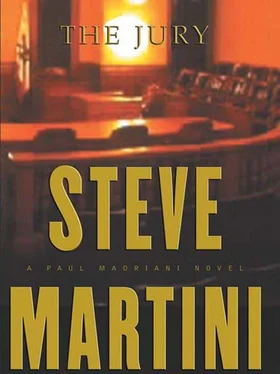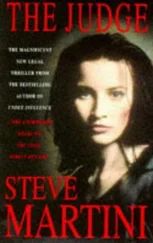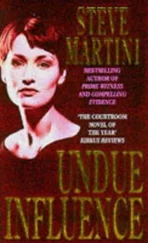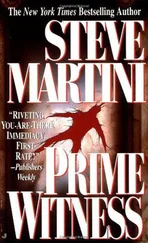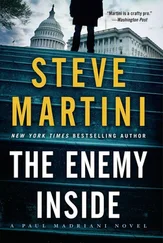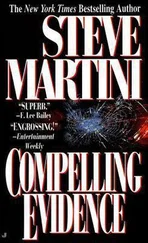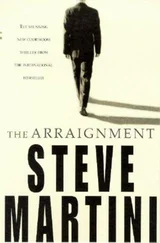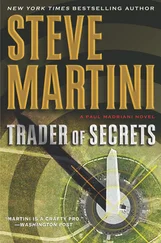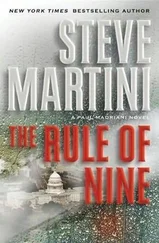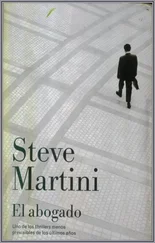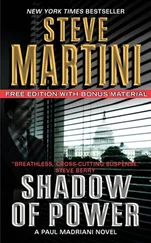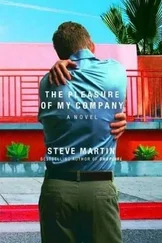Steve Martini - The Jury
Здесь есть возможность читать онлайн «Steve Martini - The Jury» весь текст электронной книги совершенно бесплатно (целиком полную версию без сокращений). В некоторых случаях можно слушать аудио, скачать через торрент в формате fb2 и присутствует краткое содержание. Год выпуска: 0101, Издательство: Penguin Group US, Жанр: Триллер, на английском языке. Описание произведения, (предисловие) а так же отзывы посетителей доступны на портале библиотеки ЛибКат.
- Название:The Jury
- Автор:
- Издательство:Penguin Group US
- Жанр:
- Год:0101
- ISBN:нет данных
- Рейтинг книги:3 / 5. Голосов: 1
-
Избранное:Добавить в избранное
- Отзывы:
-
Ваша оценка:
- 60
- 1
- 2
- 3
- 4
- 5
The Jury: краткое содержание, описание и аннотация
Предлагаем к чтению аннотацию, описание, краткое содержание или предисловие (зависит от того, что написал сам автор книги «The Jury»). Если вы не нашли необходимую информацию о книге — напишите в комментариях, мы постараемся отыскать её.
The Jury — читать онлайн бесплатно полную книгу (весь текст) целиком
Ниже представлен текст книги, разбитый по страницам. Система сохранения места последней прочитанной страницы, позволяет с удобством читать онлайн бесплатно книгу «The Jury», без необходимости каждый раз заново искать на чём Вы остановились. Поставьте закладку, и сможете в любой момент перейти на страницу, на которой закончили чтение.
Интервал:
Закладка:
“Is that important?”
“Yes. Given the pressure applied, the nylon could easily have cut the hands.”
Tannery takes all this in, nodding as he paces a few feet away from the jury box.
Now he moves toward the witness. “Doctor, can you demonstrate how you believe the killer in this case applied the cable tie around the neck of Kalista Jordan?”
“Sure. I can do that.” Schwimmer gets up from the witness chair and comes out of the box into the well just beyond the clerk’s desk. There before the judge and jury, with Tannery playing victim, the coroner approaches from behind. Deftly he slips the looped cable tie over the D.A.’s head and swiftly pulls on the gun-handled tool to tighten it just short of full tension. There is the sound of an audible zip as the nylon teeth slip through the tiny locking yoke.
“Once it is snug,” says Schwimmer, “the killer would work the trigger on the tensioning device to tighten it. Two or three pulls would do it.”
“Thank you. I think that’s enough, Doctor.” Tannery tries to remove the tie by lifting it over his head, but it has been closed too far. It is clear to me, perhaps not to the jury, that the witness and Tannery have rehearsed this. The clerk has to lend Schwimmer a pair of good-sized scissors in order to cut the loop and remove it from around Tannery’s neck. The witness steps back up into the witness box and takes a seat.
The D.A. is left feeling with one hand around his throat, a not so subtle gesture for the benefit of the jury. “All things considered, and assuming the element of surprise,” he says, “this would be a very effective weapon, would it not, Doctor?”
“Oh, yes. And silent. It makes very little noise.”
“Once it’s locked in place and tightened, it can’t be removed except by cutting the nylon tie. Is that right?” As if Tannery had not just proved the point.
“Yes. That is correct.”
Tannery heads back toward his counsel table, begs the court’s indulgence and looks over a few notes, flipping pages as if to find his place, then comes back toward the box.
“Let me ask you, Doctor. You had an opportunity to observe the ligature that was used in this case before it was removed from Kalista Jordan’s throat. Is that correct?”
“Yes.”
“Did you remove that ligature yourself?”
“I did.”
“And where did you do this?”
“In the examination room at the coroner’s office. As part of the preautopsy examination. We also took photographs at that time.”
“And as part of that examination, were you able to determine anything else regarding possible identification of the perpetrator of this crime?”
“I was able to make certain determinations.”
“For example?”
“Based on the placement of the ligature around the victim’s throat, it is my opinion that the killer was left-handed.”
As he says this, Crone, who has been copiously taking notes at the table next to me, suddenly stops and lays his pen down. Unfortunately, he isn’t quick enough. Several of the jurors are looking at the ballpoint pen resting on the table, angled like an arrow toward his left hand, which just laid it down.
“Can you tell the jury how you came to this conclusion?”
“Ordinarily with a garrote, or a piece of rope, it might be difficult to tell,” says Schwimmer, “although the dominant hand usually leaves some telltale bruising where the hands cross over. The ligature is twisted as the assailant applies pressure. But in this case it is fairly easy, and certain. The reason,” he says, “is the design of the cable tie itself.”
He picks up a fresh one from the bag as if to emphasize.
“The assailant would insert the end of the tie into the yoke, making a loop.” Schwimmer does this with the tie.
“From the tool marks on the nylon tail it is clear that the assailant used a tensioning tool to gain leverage. This would give him a solid grip on the thin nylon. In doing this, in using the tool to pull the loop closed, it is natural that the killer would use the dominant hand to pull the handle of the tool, and the weak hand to position the loop in place at the posterior of the victim’s neck. That means that when the act was completed, when the cable tie was fully tightened, the tail of the tie passing through the yoke would pass from right to left behind the victim’s neck as it exited the yoke. The tail would be in the direction of the killer’s dominant hand. In this case, the left hand. This was, in fact, what I observed before removing the cable tie from around the victim’s neck.”
“Thank you, Doctor.” Tannery has some close-up photographs of this, which the witness quickly identifies. These are marked for identification and placed into evidence without objection. He then identifies the cable tie used to kill Kalista Jordan sealed in its plastic evidence bag, still coiled in its deadly loop even though cut. This, too, is lettered for identification and moved into evidence.
“Just as a point of information, Doctor, do you have any scientific basis or knowledge as to what proportion of the general population is left-handed?” asks Tannery.
“About ten percent,” says Schwimmer.
“A distinct minority,” says Tannery.
“Correct.”
I can feel Crone as he bristles at this.
“Were you able to determine anything else from your observations during or before the autopsy?”
“Yes. It was apparent that the killer was taller than the victim. I would estimate, approximately six feet in height.”
“And how did you determine this?”
“The ligature, while being applied nearly on a level, was pulled up slightly higher at the back of the neck. As I said, above the first cervical vertebra. That would indicate that as the killer applied pressure, the ligature was being pulled just slightly upward, accounting for a difference in height. I determined the assailant to be approximately six feet tall by taking the height of the victim and the slight angle of the ligature and making some calculations.”
“I see.” Tannery then takes the witness through the process of dismemberment, the fact that Kalista Jordan’s arms and legs were severed neatly at the joints. Three of these were never found when her torso floated up on the beach along the strand.
“Could you tell how long she had been in the water?”
“At least three days.”
“Could sharks or other predators have accounted for the missing limbs?”
“Not unless they had medical training,” says Schwimmer. Several of the jurors laugh at the dark humor.
“Objection.”
“Sustained.”
“Could sharks have accounted for this?” Tannery holds up one of the photographs toward the jury.
“No. There were no tooth marks, no broken bones. Whoever dismembered the body after death knew what he or she was doing.”
“Is it likely that this person had medical or surgical training?”
“Objection.”
“I’m asking the witness for his expert opinion,” says Tannery.
“I’ll allow it,” says the judge.
“It’s possible,” says Schwimmer. “The incisions at the joints were made by a very sharp instrument.”
“Like a scalpel?”
“Possibly.”
“Thank you, Doctor. No further questions.”
Coats looks down at me. “Your witness, Mr. Madriani.”
The tactic here is always the same, playing the game of the possible. Securing little wedges of concession from the expert, issues on which he cannot be absolutely certain, and to maneuver for openings that can be exploited.
“Dr. Schwimmer. Am I pronouncing your name correctly?”
He nods and smiles.
“In your autopsy report you stated that the victim suffered several severe lacerations and contusions to the head.”
Читать дальшеИнтервал:
Закладка:
Похожие книги на «The Jury»
Представляем Вашему вниманию похожие книги на «The Jury» списком для выбора. Мы отобрали схожую по названию и смыслу литературу в надежде предоставить читателям больше вариантов отыскать новые, интересные, ещё непрочитанные произведения.
Обсуждение, отзывы о книге «The Jury» и просто собственные мнения читателей. Оставьте ваши комментарии, напишите, что Вы думаете о произведении, его смысле или главных героях. Укажите что конкретно понравилось, а что нет, и почему Вы так считаете.
